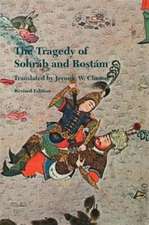A Short History of Iraq
Autor Thabit Abdullahen Limba Engleză Hardback – 29 iul 2016
The twentieth century witnessed the transformation of the area known currently as Iraq from a backward region of the Ottoman Empire, to one of the most important and dynamic states in the Middle East. The rise of modern Iraq has its roots in the second half of the nineteenth century when Ottoman reforms led to gradual state modernization and increasing integration in the World Economy. British control after World War I was one of the determining factors in the establishment of the current borders of the country and the nature of its subsequent national identity. The other important factor was the highly heterogeneous nature of Iraqi society being divided along tribal, ethnic, religious, and sectarian lines.
This book focuses on the interaction between the old and the new, or between continuity and change, as it is manifested in the nature of social development, nation-building, the state and the political opposition.
An entirely new chapter focusing on the recent conflict has been added, and will contain sections on:
The new chapter will have the following sections:
- The Question of American Intervention
- Invasion and the Fall of Saddam
- Looting & the Collapse of the Central State
- The Provisional Authority’s Reforms
- The Nature of the Resistance
- Iraq’s New Political Reality
- Elections and the Rise of Sectarian Parties
- Social-Economic Transformations
- The Challenge of the Future.
| Toate formatele și edițiile | Preț | Express |
|---|---|---|
| Paperback (1) | 351.66 lei 6-8 săpt. | |
| Taylor & Francis – 10 sep 2010 | 351.66 lei 6-8 săpt. | |
| Hardback (1) | 764.20 lei 6-8 săpt. | |
| Taylor & Francis – 29 iul 2016 | 764.20 lei 6-8 săpt. |
Preț: 764.20 lei
Preț vechi: 1027.43 lei
-26% Nou
Puncte Express: 1146
Preț estimativ în valută:
146.23€ • 159.34$ • 123.22£
146.23€ • 159.34$ • 123.22£
Carte tipărită la comandă
Livrare economică 23 aprilie-07 mai
Preluare comenzi: 021 569.72.76
Specificații
ISBN-13: 9781138835153
ISBN-10: 1138835153
Pagini: 224
Dimensiuni: 156 x 234 mm
Greutate: 0.45 kg
Ediția:Revised
Editura: Taylor & Francis
Colecția Routledge
Locul publicării:Oxford, United Kingdom
ISBN-10: 1138835153
Pagini: 224
Dimensiuni: 156 x 234 mm
Greutate: 0.45 kg
Ediția:Revised
Editura: Taylor & Francis
Colecția Routledge
Locul publicării:Oxford, United Kingdom
Cuprins
Acknowledgments. Chronology of main events. Maps. Introduction. 1. From the Arab conquest to the fall of Baghdad, 636–1258. 2. Iraq under Mongol and Turkoman rule, 1258–1534. 3. The first three centuries of Ottoman rule, 1534–1831. 4. The Tanzimat and Young Turk period, 1831–1918. 5. Mandate and Monarchy, 1918–1958. 6. The struggle for the Republic, 1958–1979. 7. The dictatorship of Saddam Husayn, 1979–2003. 8. Iraq Under American Hegemony, 2003-2009. Conclusion. Select bibliography. Index.
Notă biografică
Thabit A. J. Abdullah is Professor of History at York University, Canada. He is the author of Merchants, Mamluks and Murder: The Political Economy of Trade in Eighteenth Century Basra (2001), and Dictatorship, Imperialism and Chaos: Iraq Since 1989 (2006).
Descriere
The twentieth century witnessed the transformation of the area known currently as Iraq from a backward region of the Ottoman Empire, to one of the most important and dynamic states in the Middle East. The rise of modern Iraq has its roots in the second half of the nineteenth century when Ottoman reforms led to gradual state modernization and increasing integration in the World Economy. British control after World War I was one of the determining factors in the establishment of the current borders of the country and the nature of its subsequent national identity. The other important factor was the highly heterogeneous nature of Iraqi society being divided along tribal, ethnic, religious, and sectarian lines.
This book focuses on the interaction between the old and the new, or between continuity and change, as it is manifested in the nature of social development, nation-building, the state and the political opposition.
This book focuses on the interaction between the old and the new, or between continuity and change, as it is manifested in the nature of social development, nation-building, the state and the political opposition.





















